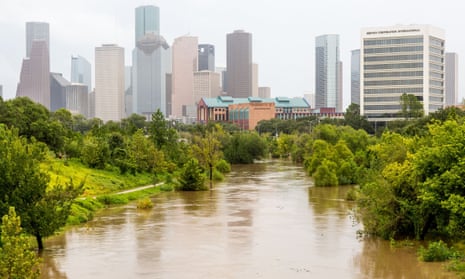It was a Eureka moment, though with plenty more water than the story about Archimedes and the bathtub. And it happened in Texas.
As he looked out of the window of an historic building he owns in the coastal city of Galveston and watched as the storm surge and rains from Hurricane Ike inundated the property with eight feet of water, a thought occurred to Bill Merrell: “The Dutch would never put up with that”.
Taking inspiration from the Netherlands’ extensive flood-protection projects, the marine science professor proposed a scheme he dubbed the Ike Dike.
The idea is a 50-to 60-mile coastal barrier that could feature seawalls, dunes, flood gates and levees to repel a storm surge and stop water barrelling up the Houston ship channel and flooding waterside areas home to hundreds of thousands of people and dozens of chemical plants, refineries and other industrial facilities, as well as Nasa’s Johnson Space Center.
Amid the global financial crisis, and in climate-change skeptic, big-government averse Texas, his idea was largely snubbed by politicians unwilling to spend heavily to guard against a theoretical storm, even though Hurricane Ike caused about $30bn of damage in the state when it struck in 2008. “Texans are not particularly risk-averse. The Dutch are,” Merrell said.
Then came last year’s Hurricane Harvey. The storm made landfall 200 miles from Houston in August 2017 and stalled for four days, dropping as much as 60 inches of rain over parts of the metropolitan area. It caused $125bn in damage, killed at least 68 people and flooded more than 300,000 structures in southeast Texas alone.

Yet in one sense, Houston got lucky. It was spared a major storm surge and hurricane-force winds. A strong hurricane making a direct hit on the Houston ship channel could cause one of the most dire environmental and economic catastrophes in US history.
“It isn’t a question of if, it’s a question of when,” the 75-year-old creator of the Ike Dike said at his office on the Texas A&M University campus on Pelican Island, just across a narrow causeway from central Galveston.
On August 25, a year to the day after Harvey’s landfall, voters in Harris County agreed to a modest increase in their property taxes when they passed a $2.5bn bond measure that will unlock billions more in federal matching funds for flood mitigation, prevention and home buyouts.
“The United States as a policy has relied on recovery instead of protection. The Europeans typically haven’t, they’ve been much more into protection. And recovery has just gotten too expensive,” Merrell said. “The other bad thing about recovery is it differentially hits the poor and the elderly because they don’t have the means to recover. So I think we’re going to look more and more to protection.”
But money is not yet secured to enact the most ambitious and costly projects, notably a third reservoir to shield west and central Houston and a barrier for the coast. Such a coastal spine would protect six counties and cost an estimated $12bn to 15bn, but so far, Congress has only provided $3.9bn for reinforcement of existing defences and limited construction of new levees.
At the end of this month a federal agency, the US Army Corps of Engineers, is expected to release a tentative coastal protection plan that, Merrell hopes, will recommend something akin to his Ike Dike. A public comment period will follow, with environmentalists likely to express concerns that the barrier might impact the natural landscape and wildlife.
Construction is unlikely to be completed before the middle of the next decade – assuming money is found to pay for it. Though the state is sitting on a so-called “rainy day” fund of $11bn, its Republican leaders want the federal government to fund it - as does the very industry whose activities contribute to climate change, which increases the intensity of hurricanes.
Local officials are considering raising money from the financial markets by persuading businesses such as oil companies to issue “resilience bonds”, Bloomberg reported. These are a new kind of risk-based instrument designed to free up money to spend on infrastructure by lowering insurance premiums.
Despite the funding battles ahead, the political and public mood has clearly shifted since Merrell first proposed the Ike Dike. Harvey was Houston’s third serious flooding event in as many years. “It’s been a decade, we haven’t moved,” he said. “People just don’t want to be flooded any more.”

Bright blue images of marlins on Merrell’s shirt contrasted with murky skies outside. The view evoked prosperity and peril: shipping facilities and the four-mile long stretch of refineries and chemical plants at Texas City. With its Manhattan-esque skyline of sky scraping flare stacks, it is an economic powerhouse and the scene of past tragedies.
Even with advance warning, escape would not be simple. A mass evacuation of Houston ahead of Hurricane Rita in 2005 caused enormous traffic snarls and about a hundred people died from causes such as heatstroke and accidents. With about 7 million people, the Houston area’s population is now two million bigger than it was then. Many live near the water, close to one of the country’s busiest ports and its largest petrochemical complex.
“We’re getting more vulnerable,” Merrell said. “We’re moving towards the coast and the seas are rising to greet us. It’s the perfect place for disaster. There are storms out there that could really kill an awful lot of us. Thousands of us. And we’re not doing anything about it.”
A day before we met, Tropical Storm Gordon made landfall near the Alabama-Mississippi border, while Hurricane Florence continued its path towards the east coast. Heavy rain recently caused street flooding in Galveston – all reminders of the region’s vulnerability and the risk that one day the worst-case scenario might be realised.
Still, ten years on from Ike’s attack on that September day, Merrell at last sees reason for optimism. “I am sensing a real impatience to get something done,” he said.
